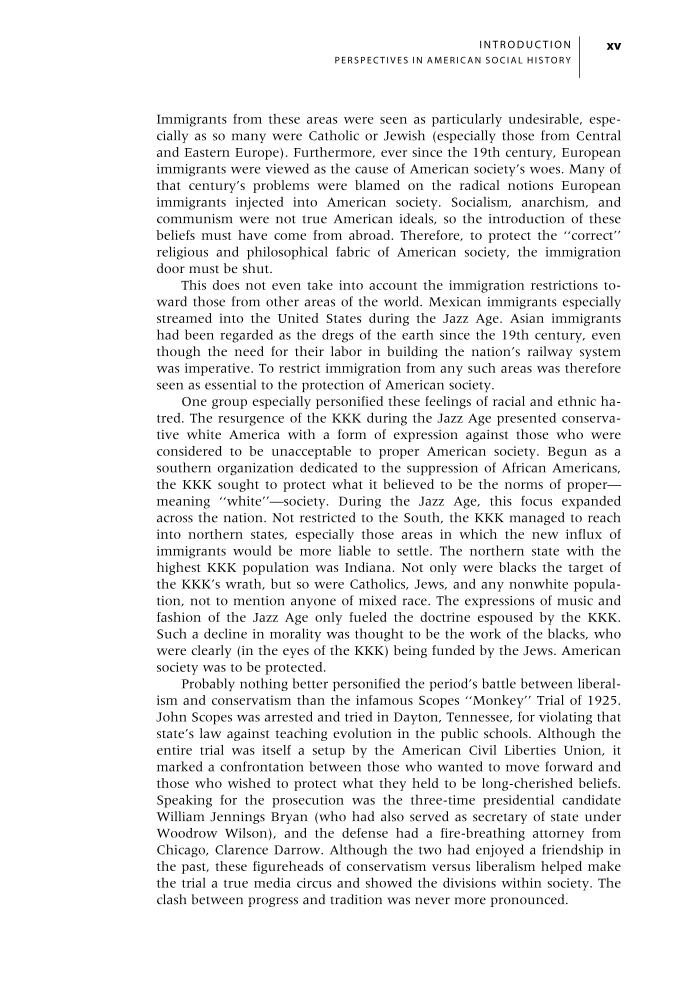Immigrants from these areas were seen as particularly undesirable, espe- cially as so many were Catholic or Jewish (especially those from Central and Eastern Europe). Furthermore, ever since the 19th century, European immigrants were viewed as the cause of American society’s woes. Many of that century’s problems were blamed on the radical notions European immigrants injected into American society. Socialism, anarchism, and communism were not true American ideals, so the introduction of these beliefs must have come from abroad. Therefore, to protect the ‘‘correct’’ religious and philosophical fabric of American society, the immigration door must be shut. This does not even take into account the immigration restrictions to- ward those from other areas of the world. Mexican immigrants especially streamed into the United States during the Jazz Age. Asian immigrants had been regarded as the dregs of the earth since the 19th century, even though the need for their labor in building the nation’s railway system was imperative. To restrict immigration from any such areas was therefore seen as essential to the protection of American society. One group especially personified these feelings of racial and ethnic ha- tred. The resurgence of the KKK during the Jazz Age presented conserva- tive white America with a form of expression against those who were considered to be unacceptable to proper American society. Begun as a southern organization dedicated to the suppression of African Americans, the KKK sought to protect what it believed to be the norms of proper— meaning ‘‘white’’—society. During the Jazz Age, this focus expanded across the nation. Not restricted to the South, the KKK managed to reach into northern states, especially those areas in which the new influx of immigrants would be more liable to settle. The northern state with the highest KKK population was Indiana. Not only were blacks the target of the KKK’s wrath, but so were Catholics, Jews, and any nonwhite popula- tion, not to mention anyone of mixed race. The expressions of music and fashion of the Jazz Age only fueled the doctrine espoused by the KKK. Such a decline in morality was thought to be the work of the blacks, who were clearly (in the eyes of the KKK) being funded by the Jews. American society was to be protected. Probably nothing better personified the period’s battle between liberal- ism and conservatism than the infamous Scopes ‘‘Monkey’’ Trial of 1925. John Scopes was arrested and tried in Dayton, Tennessee, for violating that state’s law against teaching evolution in the public schools. Although the entire trial was itself a setup by the American Civil Liberties Union, it marked a confrontation between those who wanted to move forward and those who wished to protect what they held to be long-cherished beliefs. Speaking for the prosecution was the three-time presidential candidate William Jennings Bryan (who had also served as secretary of state under Woodrow Wilson), and the defense had a fire-breathing attorney from Chicago, Clarence Darrow. Although the two had enjoyed a friendship in the past, these figureheads of conservatism versus liberalism helped make the trial a true media circus and showed the divisions within society. The clash between progress and tradition was never more pronounced. I N T R O D U C T I O N P E R S P E C T I V E S I N A M E R I C A N S O C I A L H I S T O R Y xv
Document Details My Account Print multiple pages
Print
You have printed 0 times in the last 24 hours.
Your print count will reset on at .
You may print 0 more time(s) before then.
You may print a maximum of 0 pages at a time.









































































































































































































































































































